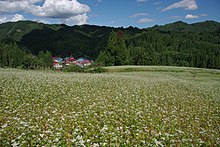|
Kitakata, Fukushima
 Kitakata (喜多方市, Kitakata-shi) is a city located in Fukushima Prefecture, Japan. As of 1 March 2020[update], the city had an estimated population of 46,269 in 16,769 households,[1] and a population density of 83 persons per km2. The total area of the city was 554.63 square kilometres (214.14 sq mi). Kitakata was once written '北方', which meant 'northern place'.[2] GeographyKitakata is located at the far northern Aizu region of Fukushima Prefecture, bordered by Yamagata Prefecture to the north and Niigata Prefecture to the west.[3]
Neighboring municipalitiesFukushima Prefecture Niigata Prefecture Yamagata Prefecture ClimateKitakata has a Humid continental climate (Köppen Dfb) characterized by warm summers and cold winters with heavy snowfall. The average annual temperature in Kitakata is 11.6 °C. The average annual rainfall is 1426 mm with September as the wettest month. The temperatures are highest on average in August, at around 25.5 °C, and lowest in January, at around -1.1 °C.[4]
DemographicsPer Japanese census data,[7] the population of Kitakata has declined over the past 60 years.
HistoryThe area of present-day Kitakata was part of ancient Mutsu Province, and formed part of the holdings of Aizu Domain during the Edo period. The town developed as a local administrative center and market town, noted for its lacquerware and brewing of sake. After the Meiji Restoration, it was organized as part of Yama District, Fukushima Prefecture. The town of Kitakami was created with the establishment of the modern municipalities system on April 1, 1889. In 1882, more than 3,000 peasants gathered at the Danjo-ga-hara Field in Shiokawa and then marched on the Kitakata Police Station to rebel against the oppression of the prefectural government. Known as the Kitakata Incident of 1882, it was the first public expression of the Freedom and People's Rights Movement in the Tohoku area.[2] Kitakata Town was raised to city status on March 31, 1954, after merging with Matsuyama village, Kamisammiya village, Iwasuki village, Sekishiba village, Kumakura village, Keitoku village, and Shiokawa village. On January 4, 2006, the towns of Shiokawa and Yamato, and the villages of Atsushiokanō and Takasato (all from Yama District) were merged into Kitakata. Government Kitakata has a mayor-council form of government with a directly elected mayor and a unicameral city legislature of 25 members. Kitakata, together with Yama District contribute two members to the Fukushima Prefectural Assembly. In terms of national politics, the city is part of Fukushima 4th district of the lower house of the Diet of Japan. Economy Kitakata is a local commercial center. Agricultural products include rice and hops. The area is traditionally noted for sake brewing and lacquerware. Modern industries include aluminum smelting. EducationKitakata has 17 public elementary school and seven public junior high schools operated by the city government, and four public high schools operated by the Fukushima Prefectural Board of Education. The prefecture also operates a vocational training school. TransportationRailwayHighwayLocal attractions
Sister citiesNoted people from Kitakata
References
External links
|
||||||||||||||||||||||||||||||||||||||||||||||||||||||||||||||||||||||||||||||||||||||||||||||||||||||||||||||||||||||||||||||||||||||||||||||||||||||||||||||||||||||||||||||||||||||||||||||||||||||||||||||||||||||||||||||||||||||||||||




